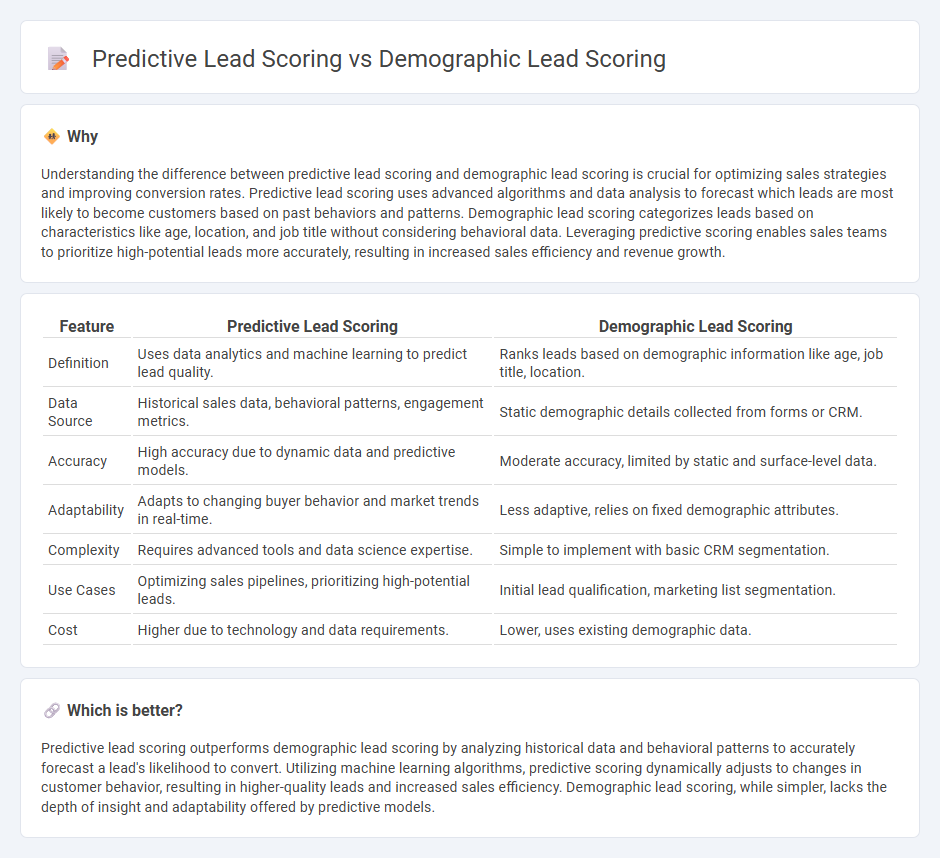
Predictive lead scoring leverages machine learning algorithms and historical data to identify high-potential prospects by analyzing behavioral patterns and engagement metrics. Demographic lead scoring relies on fixed criteria such as age, location, and job title to rank leads, often missing nuanced signals that indicate purchase intent. Explore how integrating predictive lead scoring can enhance your sales strategy and increase conversion rates.
Why it is important
Understanding the difference between predictive lead scoring and demographic lead scoring is crucial for optimizing sales strategies and improving conversion rates. Predictive lead scoring uses advanced algorithms and data analysis to forecast which leads are most likely to become customers based on past behaviors and patterns. Demographic lead scoring categorizes leads based on characteristics like age, location, and job title without considering behavioral data. Leveraging predictive scoring enables sales teams to prioritize high-potential leads more accurately, resulting in increased sales efficiency and revenue growth.
Comparison Table
| Feature | Predictive Lead Scoring | Demographic Lead Scoring |
|---|---|---|
| Definition | Uses data analytics and machine learning to predict lead quality. | Ranks leads based on demographic information like age, job title, location. |
| Data Source | Historical sales data, behavioral patterns, engagement metrics. | Static demographic details collected from forms or CRM. |
| Accuracy | High accuracy due to dynamic data and predictive models. | Moderate accuracy, limited by static and surface-level data. |
| Adaptability | Adapts to changing buyer behavior and market trends in real-time. | Less adaptive, relies on fixed demographic attributes. |
| Complexity | Requires advanced tools and data science expertise. | Simple to implement with basic CRM segmentation. |
| Use Cases | Optimizing sales pipelines, prioritizing high-potential leads. | Initial lead qualification, marketing list segmentation. |
| Cost | Higher due to technology and data requirements. | Lower, uses existing demographic data. |
Which is better?
Predictive lead scoring outperforms demographic lead scoring by analyzing historical data and behavioral patterns to accurately forecast a lead's likelihood to convert. Utilizing machine learning algorithms, predictive scoring dynamically adjusts to changes in customer behavior, resulting in higher-quality leads and increased sales efficiency. Demographic lead scoring, while simpler, lacks the depth of insight and adaptability offered by predictive models.
Connection
Predictive lead scoring leverages machine learning algorithms to analyze historical sales data and identify patterns that indicate a lead's likelihood to convert, while demographic lead scoring assigns value based on specific attributes such as age, location, and job title. Both methods integrate to create a comprehensive lead evaluation framework, enhancing targeting accuracy in sales processes. By combining predictive analytics with demographic insights, organizations increase conversion rates and optimize resource allocation in lead nurturing strategies.
Key Terms
**Demographic Lead Scoring:**
Demographic lead scoring evaluates potential customers based on specific characteristics such as age, location, job title, company size, and industry, enabling businesses to target leads that match their ideal customer profile. By leveraging this data, marketers can efficiently prioritize leads most likely to convert, optimizing the sales funnel and increasing ROI. Explore more about how demographic lead scoring can enhance your lead generation strategy.
Firmographics
Demographic lead scoring evaluates potential customers based on individual attributes such as age, job title, and income, while predictive lead scoring incorporates firmographic data like company size, industry, and revenue to assess lead quality more precisely. Firmographics play a crucial role in predictive lead scoring models by providing vital insights into organizational context, helping marketers prioritize leads from companies that match their ideal customer profile. Explore how integrating firmographic analytics can enhance your lead scoring strategy for improved sales conversion rates.
Job Title
Demographic lead scoring evaluates prospects based on job title, company size, and industry to determine fit, while predictive lead scoring uses machine learning to analyze historical data and identify patterns that predict conversion likelihood. Job title is pivotal in demographic scoring as it directly impacts lead qualification, whereas predictive models weigh job title alongside behavioral and engagement metrics for deeper accuracy. Explore further to understand how integrating both methods can optimize lead qualification and enhance sales strategies.
Source and External Links
Why Lead Scoring Matters and 4 Models You Need to Know - Demographic lead scoring ranks leads based on how closely their profile (e.g., job title, age, gender, location) matches your ideal customer persona, helping sales teams prioritize the most promising prospects.
Demographic vs. Behavioral Lead Scoring in B2B Explained - This method analyzes basic customer information like industry, company size, and location to quickly identify target groups, though it risks oversimplifying buyer diversity within those segments.
Lead Scoring Examples (10 Methods, Metrics and Signals) - Demographic and firmographic scoring assigns points to leads based on how well their attributes (e.g., age, income, occupation, industry, company size) align with your best customers, enabling more targeted marketing and sales outreach.
 dowidth.com
dowidth.com